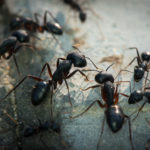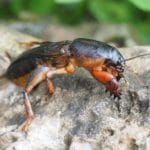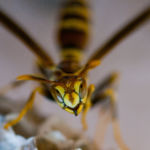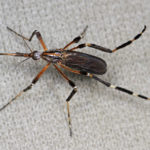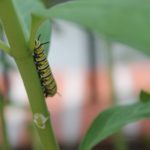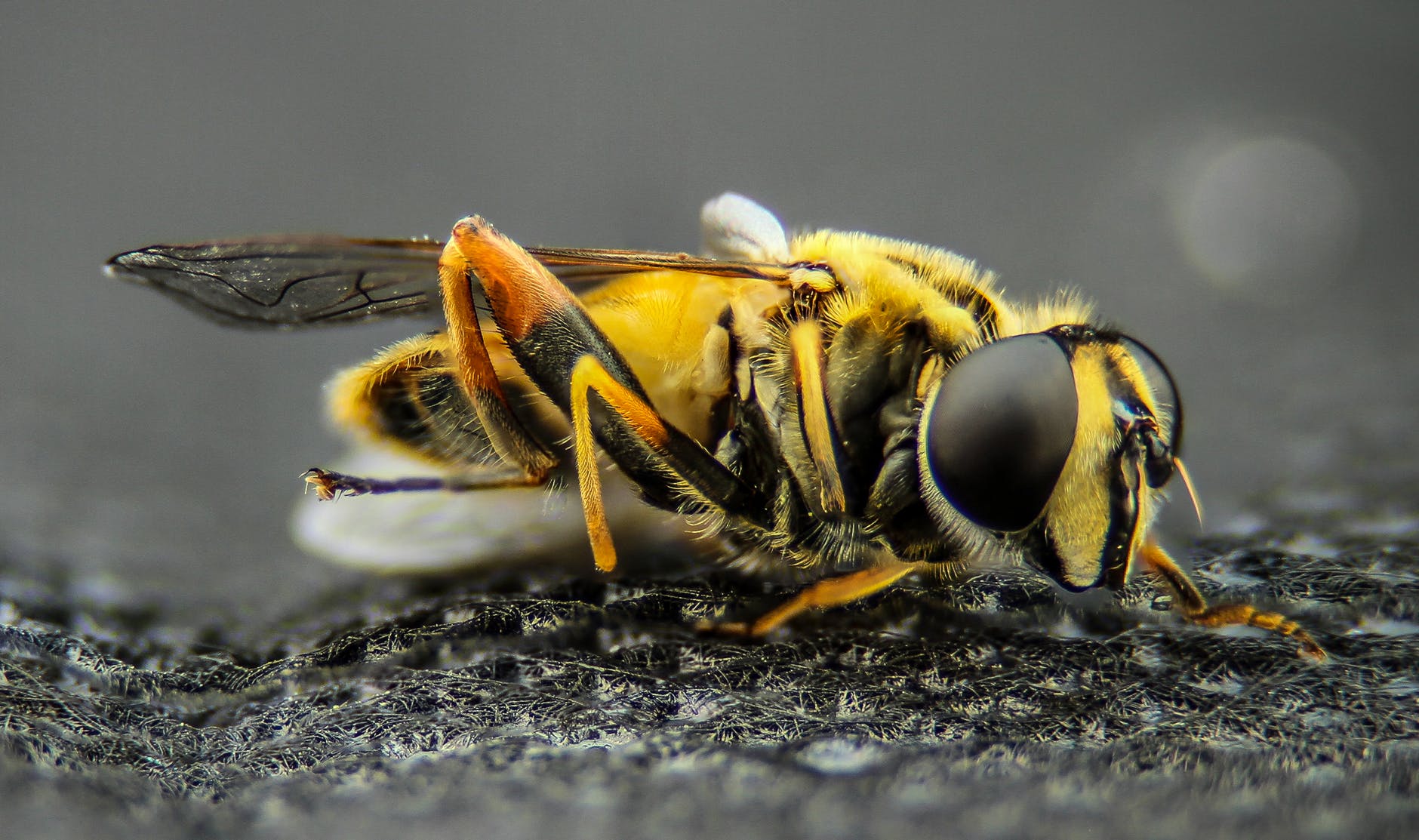
Stinging insects can provoke a wide range of human emotions, from mild annoyance to outright panic. Many bee and wasp species are beneficial because they pollinate plants and flowers. Others help control insect populations by feeding on them. That’s small comfort if you’ve got a nest on or near your home, or if you’re allergic to the venom. Read on to learn more about the most common stinging pests that plague Charlotte.
Yellow Jackets
Yellow jackets (pictured above)are notorious pests that sting and bite. These predatory wasps are common throughout North America. They’re small with black and yellow markings on their heads and bodies. They build their tan, papery nests in the ground or in empty spaces between walls. You might find their nests in your lawn, at the base of shrubs or trees, in hollow logs, or under the eaves of your house. They mostly eat insects such as bees and flies. They’re attracted to meat and sweet juices, which is why you’ll find them hovering on your hamburger or soda can at your backyard barbecue.
Yellow jackets will aggressively defend their nests. They’ll attack in swarms if someone steps on or hits a nest. They’ve also been known to attack unprovoked. Ground vibrations can trigger an attack, so mowing your lawn can be dangerous in late summer when their colonies are large. They’ll bite you to get a better grip on your flesh, then they’ll stab you with their stinger. They don’t lose their stingers so they can sting many times.
Your best defense against yellow jackets is to keep all outside trash containers tightly covered. If you find a nest, you can spray it with a pyrethrum aerosol. But only spray at night. Yellow jackets don’t see well in the dark, and you’ll reduce your chance of being stung. Keep in mind, the entire colony will be in the nest at night, and these critters sting when threatened. This is one job you may want to leave to the professionals.
Carpenter Bees
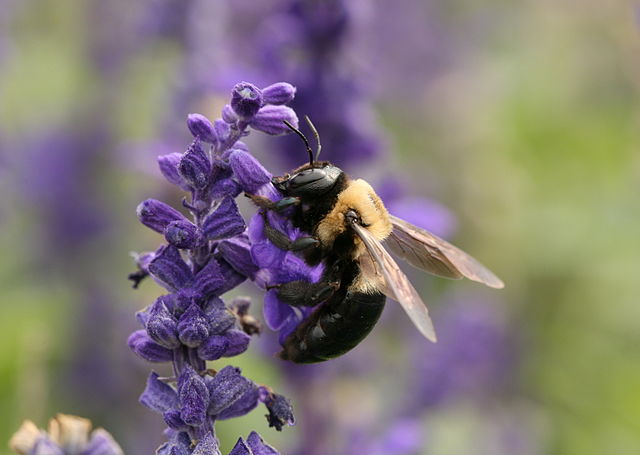
Carpenter bees look a lot like bumblebees, except their abdomens are shiny, black and hairless (bumblebees have hairy bellies with yellow stripes). Females tunnel holes in wood to raise their young. Favorite nesting spots include wood shake roofs, decks, rafters, eaves, siding, and outdoor furniture. They are beneficial pollinators and rarely sting. The males hover in an area while on the lookout for females to mate with in the spring. You may have experienced these large bees hovering and buzzing near your head. This is annoying and can be frightening, but keep in mind the males don’t have stingers and can’t hurt you.
Cicada Killers
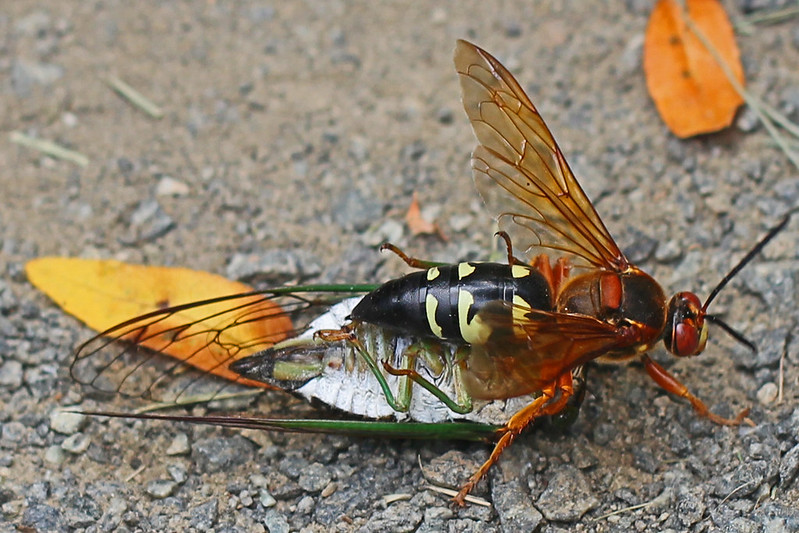
True to their name, these black and yellow wasps kill cicadas. Adult females paralyze cicadas with their venom, then carry the cicada back to their burrows. They lay an egg under the cicada. When the larva hatches, it’ll feed on the cicada then spin a cocoon to become an adult wasp. Cicada wasps are large and look very threatening, but they usually won’t sting you unless you harass, squeeze, or step on one. They like to burrow underground in open, dry areas. Another reason to water your lawn regularly… especially if you like to walk barefoot on the grass.
European Hornets

These large hornets are brown with yellow stripes. They’re also called giant or brown hornets and were introduced in the United States from Europe in the 1800s. European hornets like to nest in protected places like hollow trees, under decks or porches, or in empty cavities in walls. Unlike other stinging insects, European hornets are active at night. North Carolina State University’s extension agent, Dr. Michael Waldvogel says, “They’re usually attracted to lighted windows. They sometimes fly into the glass, startling people. But they’re not aggressive and will usually only sting when they feel threatened.”
Honey Bees
Honey bees are crucial to ecosystems across the planet because of their pollinating powers.
Their colonies have three different types of bees.
- The queen lays eggs and runs the hive.
- Workers are all female, and they’re the only ones we see outside the hive. They collect pollen and nectar from flowers to produce honey. They also build and protect the hive.
- Drones are male bees that mate with the queen.
“Honey bees aren’t aggressive, but they will sacrifice their lives to protect their colony,” says Dr. Waldvogel. These are the only type of bees that die after stinging you. The barbed stinger stays in your skin after the bee tears itself away. Honey bees are normally very docile and won’t sting you unless you bother them or their colony. If you find a nest near your home, your best bet is calling a beekeeper to remove it.
Paper Wasps
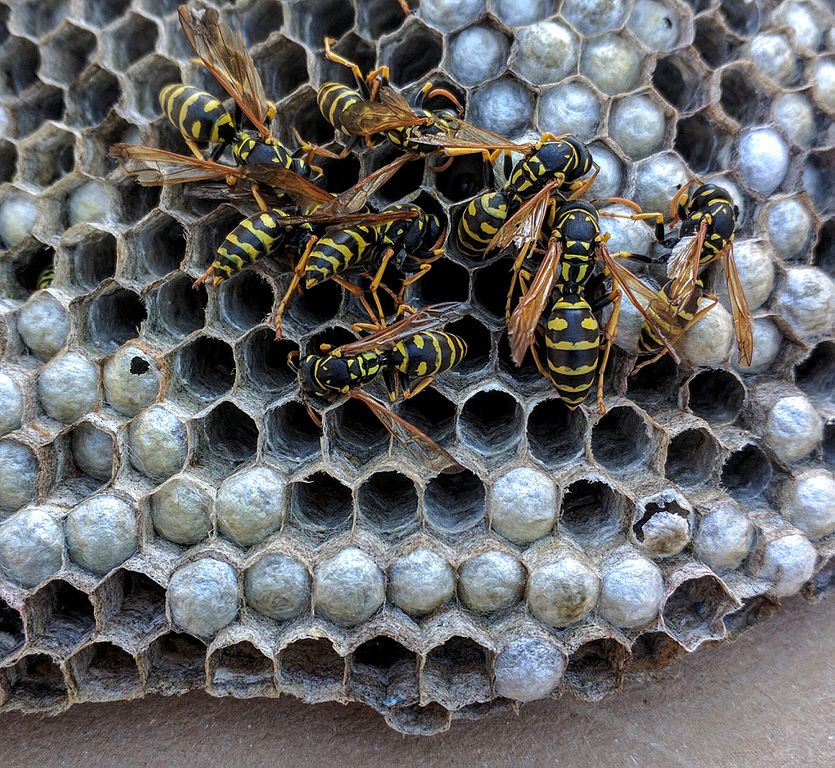
These wasps get their name from their distinctive, umbrella-shaped nests that look like they’re made out of paper. They have slender, black bodies with yellow markings and black wings. The queens build their nests with a combination of plant materials and saliva. They prefer protected areas like eaves, door frames or thick vegetation. While these aren’t the most aggressive wasps, they’ll deliver a painful sting to defend their colonies and their queens.
Beware Allergic Reaction to Stings
It’s important to note that insect stings can cause a severe and life-threatening allergic reaction (anaphylaxis) in some people. Seek immediate medical attention if you have difficulty breathing or swallowing after a sting, or if you feel dizzy, faint, or nauseous. In most cases, reactions to a sting are mild. They can cause redness, itching, and some swelling. Most symptoms will subside after a day or two.
Don’t let your guard down in the winter. You won’t see many of these stinging insects, but many of them are nesting in the wood frame of your house, or maybe even your attic. A professional can help you identify the worst stinging pests, and remove them before they reappear in the spring.
